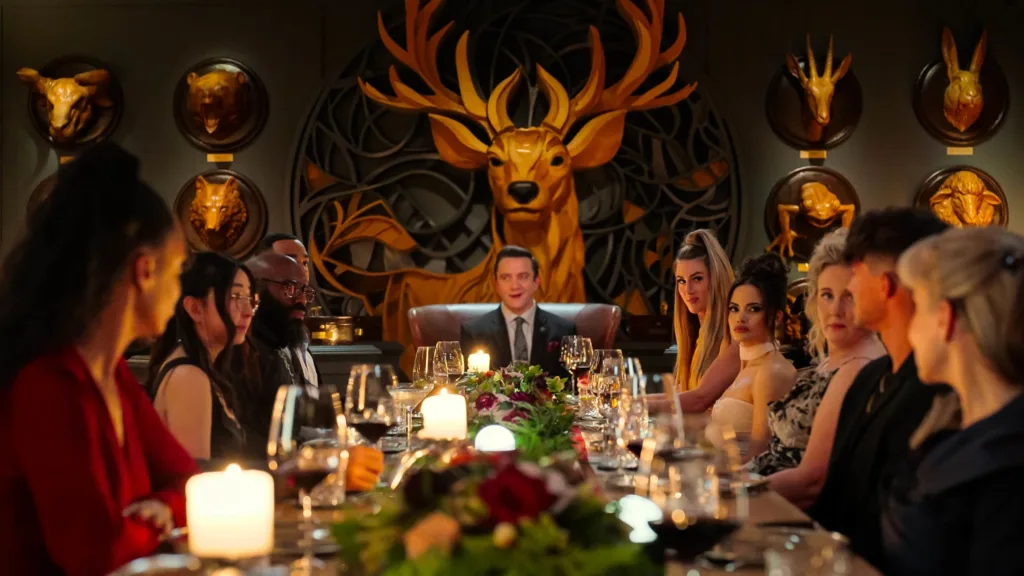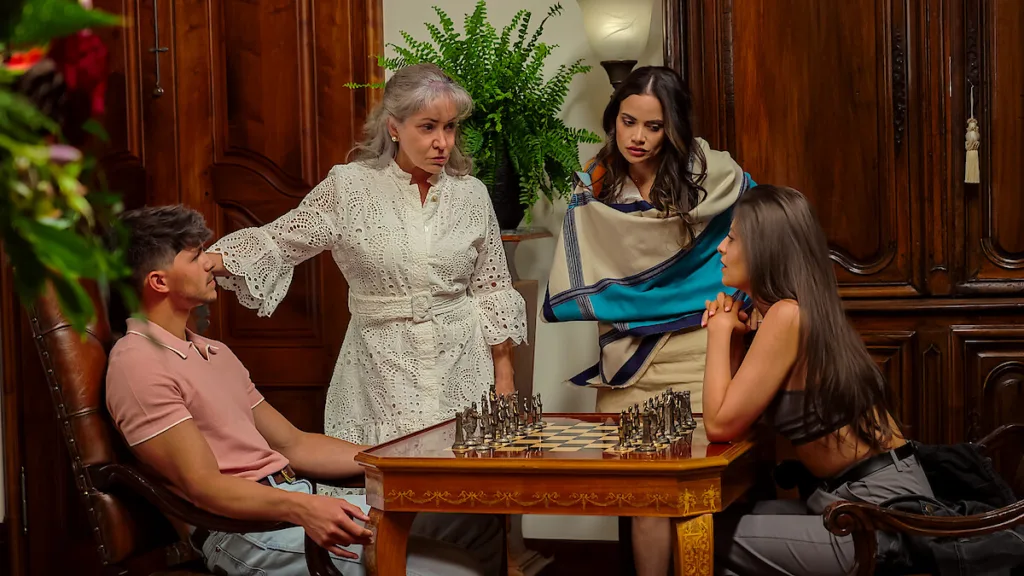Million Dollar Secret introduces a novel competition format where one contestant is entrusted with a million-dollar prize from the outset. A group of strangers gathers in an upscale estate—a mansion or lakeside hotel—that serves as a stage for both opulent surroundings and simmering tension.
The concept immediately captures attention: the prize is not earned through gradual accumulation but is granted at the very beginning, with its holder challenged to maintain secrecy amid constant suspicion. The show’s structure places contestants in a scenario that is as much about personal strategy as it is about high-stakes deception.
The unexpected twist lies in the mechanism of prize retention: the money can be transferred if the holder is exposed, creating an environment that is equal parts suspenseful and unpredictable. The format transforms the competition into a dynamic contest of concealment and revelation, where every interaction carries significant risk.
Viewers encounter a production that combines theatrical presentation with calculated strategic maneuvers. Lavish visuals enhance an atmosphere charged with risk, where trust is elusive and wealth transforms into both a prized reward and a potential liability. This approach speaks directly to current attitudes in streaming television, reflecting modern views on power, status, and the delicate balance of personal ambition versus collective scrutiny.
Mechanics and Game Dynamics
The competition assembles a dozen participants, each stepping into a carefully designed arena where the rules of engagement are immediately clear. At check-in, every contestant discovers a box on their bed; among these, only one conceals the million-dollar prize. This initial distribution of mystery sets a stage where hidden identities drive the unfolding drama.
Participants face a series of physical and mental challenges that test not only their athletic ability but also their capacity for observation and critical thinking. These tasks range from obstacle courses to puzzles that offer crucial hints regarding the secret holder. Success in these competitions provides tactical benefits such as additional votes or the ability to nullify a vote. This mix of challenges generates an environment of calculated risk and strategic advantage.
Adding complexity to the contest is a secret task given exclusively to the holder of the million-dollar box. This covert assignment demands that the millionaire complete certain objectives discreetly, balancing the need to perform against the imperative to remain indistinguishable from the others. The hidden assignment layers the competition with an extra dimension, prompting the prize-holder to carefully modulate behavior under constant scrutiny.
Every evening, the contestants converge for a vote that serves as both a ritual and a turning point in the game. The tension mounts as accusations fly and alliances are tested during these sessions, culminating in a dramatic reveal that either confirms or disproves suspicions.
Should the secret be uncovered, the mechanism of the game shifts; the cash prize then passes to a different contestant. This process infuses each round with volatility and keeps the competition in a state of continuous flux, where trust is a scarce commodity and every decision carries significant weight.
Characters in the Spotlight
The series presents a cast of 12 participants drawn from various walks of life, ranging from those who exude dramatic flair to individuals whose quiet reserve masks a strategic mind. Some figures arrive with roles that might be seen as clichés—like the earnest scholar or the overconfident risk-taker—while others surprise viewers with layers that defy initial expectations. Personal histories, secret ambitions, and unspoken vulnerabilities all add texture to these portrayals, offering commentary on how public images are often at odds with private realities.
Rapidly forming alliances and sharp rivalries serve as the heartbeat of the show. In moments of forced intimacy, such as group challenges or impromptu discussions, viewers witness relationships that shift from tentative trust to palpable suspicion.
Every handshake and shared anecdote becomes a subtle battleground where contestants test loyalties, reveal hidden agendas, or stage misdirection. These interactions mirror current societal debates about trust and transparency in both personal and public spheres.
Standard archetypes appear and evolve throughout the series—consider the outsider whose unconventional tactics challenge group norms, or the strategist whose quiet observations lead to unexpected moves.
These evolving roles highlight how early impressions can be misleading; each character’s journey is a study in adaptation and survival within a pressured environment. Contestants employ psychological tactics that range from playful banter to calculated bluffing, often drawing a wry smile from viewers who recognize the familiar theatricality of reality TV.
The show’s deliberate casting contributes a mix of cultural and socioeconomic backgrounds, underscoring the importance of diverse perspectives. This varied ensemble not only enriches the narrative but also reflects ongoing shifts in the media industry toward more inclusive storytelling. Every personal motivation and strategic decision is a microcosm of broader societal shifts, marking the series as a harbinger of changes in how television portrays identity and power dynamics.
Production Design, Setting, and Cinematic Style
The series situates its drama in an opulent estate, a secluded mansion by a serene lake or an upscale hotel, where lavish surroundings clash with an undercurrent of tension. This setting creates a striking contrast: polished glamour appears side by side with the simmering anxiety of hidden identities. The luxurious backdrop serves as a silent character, heightening the stakes of every interaction.
The visual execution employs deliberate camera work that captures both expansive views of the grand estate and intimate exchanges among the contestants. Shots linger on elegantly decorated corridors and sunlit rooms, while careful framing during moments of suspicion amplifies the emotional charge. Slow-motion sequences and unexpected cutaways punctuate the narrative, drawing attention to the minutiae of body language and fleeting expressions.
Music and sound design enhance the atmosphere, using a mix of dramatic pop tunes and subtle instrumental scores that underscore the unfolding drama. Ambient sounds and the measured tone of the announcer work together to intensify the experience, complementing the visual storytelling with layers of irony and wit. These audio elements contribute to an environment where every note seems to underscore the tension simmering beneath the surface.
The set itself is crafted with meticulous detail, from ornate dining areas used during elimination scenes to private rooms decorated with thoughtful flair. Key props, such as the distinctive boxes placed on each contestant’s bed and items associated with secret assignments, reinforce the structure of the game and add depth to the experience. Each design choice seems carefully considered, enriching the narrative while hinting at the social dynamics and personal dramas that unfold.
The production design creates an atmosphere that is at once polished and raw. The balance of refined aesthetics with palpable human drama offers a canvas on which cultural shifts and evolving storytelling forms are vividly portrayed.
Host Performance and Narrative Framing
Peter Serafinowicz stands at the center of the show’s storytelling, his dry humor and deliberate delivery setting the rhythm for every twist in the contest. He serves as a steady figure amid shifting alliances and whispered strategies, his performance infusing moments of tension with a subtle ironic twist. His measured expressions and carefully timed pauses suggest a world where every glance and word may alter the balance of trust among the contestants.
Throughout the episodes, his commentary provides both context and a hint of playful mischief. A well-placed remark or a knowing look often prompts unexpected reactions, steering the emotional energy of the group and revealing layers of personal ambition. His role extends beyond mere narration; it becomes a catalyst that influences the power dynamics at play, encouraging participants to question motives and reexamine loyalties.
Serafinowicz’s wardrobe and mannerisms evoke a nod to classic television hosts, marrying traditional elements with a contemporary edge. The choice of attire and his poised stance lend him an air of sophistication that contrasts sharply with the high-pressure environment the contestants navigate. This deliberate presentation not only heightens the drama but also serves as a visual reminder of the show’s commitment to a polished aesthetic.
Every segment of his dialogue helps stitch together the unfolding scenes, providing clarity during moments of both calm and chaos. His ability to maintain a clear narrative thread ensures that the audience is continually drawn into the unfolding drama, while his occasional wry humor offers a respite from the intensity. In short, his presence plays a pivotal role in guiding viewers through the ever-changing landscape of the game.
Tension, Drama, and Thematic Elements
The series transforms everyday exchanges into contests of psychological acumen, where every conversation becomes a battleground of suspicion. Contestants, under the weight of constant uncertainty, find that trust is as volatile as the high-stakes competition itself.
The pressure builds as interactions, even the most casual, may turn into a strategic move in disguise. The atmosphere remains charged with anxiety and a constant readiness to question intentions, mirroring today’s debates over trust and identity in society.
A key element of the series is the conflict between public personas and hidden realities. Participants must conceal not only the obvious secret of their fortune but also personal details that might expose vulnerabilities. This struggle acts as a mirror to current discussions about transparency and self-representation in media. Personal doubts and ingrained biases play out in real time, giving rise to alliances and rivalries that reflect modern social dynamics.
Game theory is interwoven into the structure of the contest. Each vote and every decision is carefully calculated, weighing immediate rewards against the risks of prolonged exposure. The challenges and unpredictable eliminations create a narrative rhythm that keeps viewers alert to every subtle shift. The movement from high-energy tasks to quiet, intense gatherings transforms simple dining moments into arenas for strategic decision-making.
Notably, the competition’s mechanics echo broader social commentary. The need to hide a significant fortune resonates with experiences where individuals mask parts of themselves to meet societal expectations.
This dynamic raises questions about authenticity versus performance in a media landscape defined by carefully curated images. The balance of secrecy and revelation reflects ongoing debates about privacy and the true cost of openness, prompting viewers to consider how everyday interactions can mirror the calculated nature of social behavior.
The Review
Million Dollar Secret
The series delivers a mix of calculated gameplay and insightful social commentary, challenging the norms of reality television while engaging with themes of trust and personal identity. Its sumptuous setting and layered character dynamics offer a captivating experience, even if its format recalls familiar territory. The show succeeds in sparking discussion on modern societal expectations without straying into territory of radical innovation.
PROS
- Engaging social commentary and thought-provoking themes
- Lavish, visually appealing production design
- Dynamic interplay among contestants
- Clever twist on the established reality competition format
- Memorable host performance that ties the narrative together
CONS
- Format can feel predictable at times
- Overreliance on familiar reality TV tropes
- Some challenges appear uneven in difficulty
- Limited innovation in gameplay mechanics




















































